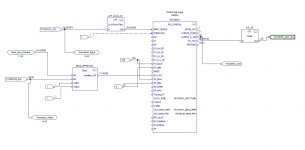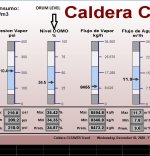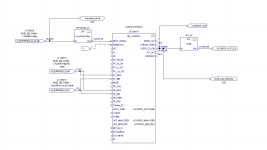widelto
Member
HI All :
We have a boiler that can produce up to 75000 lb/hour, this boiler has two CompactLogix Plcs from Allen Bradley , one is used for burner
management and the other one is used for combustion control.
This system was designed and commisioned by a contractor, I am trying to learn boiler control and I found the there are three way to control a boiler:
Single, 2 and 3 element control.
Attached you will find several pictures as follows:
RS5000 Drum level control , this the way drum level is configured and working right now, this is done thru and AOI. This system is a Single-Element Control.
Drum Level, this is our scada picture of level control, numbers (regulation) are ok. You can see last 30 minutes values, max, min and mean values.
Two Element control, I found this figure from a book and I would like to change my control to a new one like this.
New control, this is the way I would like the new control to be implemented.
My doubts are the following:
I would like to know how to put my steam flow value into the equation (steam flowmeter is already installed and working properly), I do not see how my flowmeter data (4-20 mA)or lb/hour can be squared rooted as two-element control suggest. In other words, I want to know how to handle K Factor in my "New Control" figure.
Do I need to use a scale factor in order to mix (sum) data from level controller and data from steam flowmeter ??
I also read that steam flow data can be used as a feedforward into the PIDE control. Same question as before Do I need to extract squared root from steam flowmeter and then scale it to be entered as a feedforward into my PIDE ??
Regards,
william




We have a boiler that can produce up to 75000 lb/hour, this boiler has two CompactLogix Plcs from Allen Bradley , one is used for burner
management and the other one is used for combustion control.
This system was designed and commisioned by a contractor, I am trying to learn boiler control and I found the there are three way to control a boiler:
Single, 2 and 3 element control.
Attached you will find several pictures as follows:
RS5000 Drum level control , this the way drum level is configured and working right now, this is done thru and AOI. This system is a Single-Element Control.
Drum Level, this is our scada picture of level control, numbers (regulation) are ok. You can see last 30 minutes values, max, min and mean values.
Two Element control, I found this figure from a book and I would like to change my control to a new one like this.
New control, this is the way I would like the new control to be implemented.
My doubts are the following:
I would like to know how to put my steam flow value into the equation (steam flowmeter is already installed and working properly), I do not see how my flowmeter data (4-20 mA)or lb/hour can be squared rooted as two-element control suggest. In other words, I want to know how to handle K Factor in my "New Control" figure.
Do I need to use a scale factor in order to mix (sum) data from level controller and data from steam flowmeter ??
I also read that steam flow data can be used as a feedforward into the PIDE control. Same question as before Do I need to extract squared root from steam flowmeter and then scale it to be entered as a feedforward into my PIDE ??
Regards,
william











